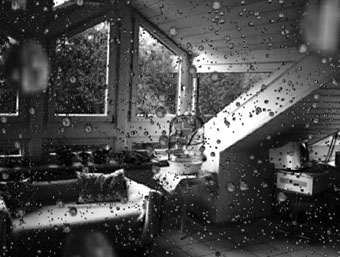Seriously weird worlds
Ashley Crawford on ACMI's Transfigure

Tamás Waliczky, Landscape, 1997
The infamous Stelarc has created an interactive head that talks with viewers—type in a question and dread the answer. Canadian Char Davies will take you on a serious trip in her immersive virtual reality environments and if that doesn’t get you going, check out Chris Cunningham’s robot sex, filmed for a music video for Icelandic singer Björk.
Transfigure: Perception, body, space & landscape transformed by the moving image is arguably one of the most ambitious—and successful—new media exhibitions Australia has ever hosted. Curated by Alessio Cavallaro, the senior producer and curator of new media projects at the Australian Centre for the Moving Image (ACMI), Transfigure features 15 artists from 6 countries. The show is downright weird, in a wonderful way.
Transfigure is Luna Park for the new millennium. Teenagers interact with acmipark, a 3D game world depicting simulated versions of ACMI and Federation Square which morph into strange fictional spaces. A teenage boy inquires whether you can shoot people in the game.
But Transfigure has much more to offer than a shoot ‘em up video game. Next to Cunningham’s essentially emotive response to robotics, are Paul Brown’s chromos, Ed Burton’s Sodaconstructor and Drew Berry’s body code which play with notions of genetics, chromosome structures and DNA formations, all of which are linked by an almost painterly approach.
Down the hall Justine Cooper is being cut up slice by slice. Her work, Rapt, is the result of the artist undergoing 6 hours of Magnetic Resonance Imaging which uses magnetic fields to map the body for diagnostics. The resulting video is elegant and chilling, a fascinating dissection of the human body. The video finishes with an image of Cooper’s face, which a number of viewers say has a powerfully spiritual impact, a kind of curious analogy to the Shroud of Turin.
The exhibition moves into a realm of powerful video works. Ian Andrew’s Departure comprises found video footage. Grainy and damaged, it evokes a sense of conspiracy a la the famous Zapruder footage of the JFK assassination. The work is presented on 3 tiered high-resolution plasma screens creating a strange contrast between discarded detritus and the hi-tech. The result suggests an obsessive forensic approach to uncovering the unseen.
Similarly surreal, Hungarian artist Tamas Walicky’s Landscape depicts a European village frozen in time, snowflakes suspended as the viewer revolves around the buildings. It is a technique used in the first Matrix film, however Walicky used it 3 years before the Wachowski Brothers.
Transfigure concludes with the stunning immersive works of Char Davies. Not for the faint hearted, Davies world is a spectacular example of the potential of virtual reality. Her installation, Ephémère, is a mind boggling trip into virtual reality. There are 2 very distinct experiences here. The first is that of passive observer, watching a screen version of Davies’ world and the shadow of an individual in full VR gear traversing her strange landscapes. The second is becoming an actual part of Ephémère, donning the VR helmet and flying through Davies’ grainy multi-coloured landscape.
Ephémère and Davies’ other work on show, Osmose, are immersive virtual environments with stereoscopic 3D computer graphics, spatialised sound and real time interaction colouration. Davies’ desire to convey a sense of spatial envelopment is what led her to abandon painting in the mid-1980s and become involved with 3D computer technology. She hoped the new technologies would free her from the limitations of the 2D picture plane, and allow her to effectively work in an enveloping 3D space. “Once I was making images with 3D software, I wanted to bring my audience with me into that space,” she says. “So I turned to the medium of immersive virtual space—or what many people call virtual reality.”
The other work that leaves a lasting impact is Stelarc’s Prosthetic Head. Stelarc stitched together an IBM text speech engine, modified, customised and personalised the Alice Chat Bot Engine and then used a source code for facial animation. “The difficulty really was interfacing bits of software that weren’t actually designed to run with each other,” writes Stelarc. The project was put together over an intensive 8 months with the assistance of 3 programmers in San Francisco. The head had to be constructed as a 3,000 polygon mesh and the digital skin was then wrapped around it, giving it the appearance of the artist.
More than a little unnerving, the huge head dominates a dark room, looming and hovering, deep brown eyes occasionally darting around the space. A visitor sits at a keyboard in the corner. Checking just how self-aware this strange creature is, he types in “What colour are your eyes?” “Blue,” comes the reply in a guttural, almost machine-like voice, “But I’m wearing contact lenses.”
Transfigure: Perception, body, space & landscape transformed by the moving image, curator Alessio Cavallaro, Australian Centre for the Moving Image, Federation Square, Melbourne, Dec 8, 2003-May 9, 2004
RealTime issue #59 Feb-March 2004 pg. 26






